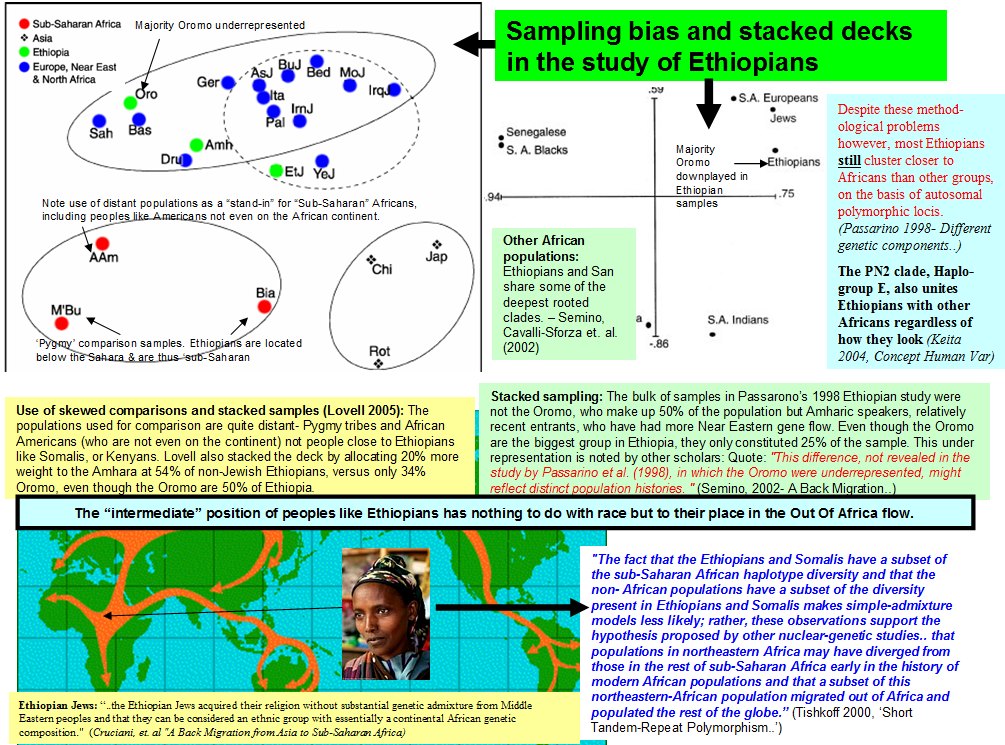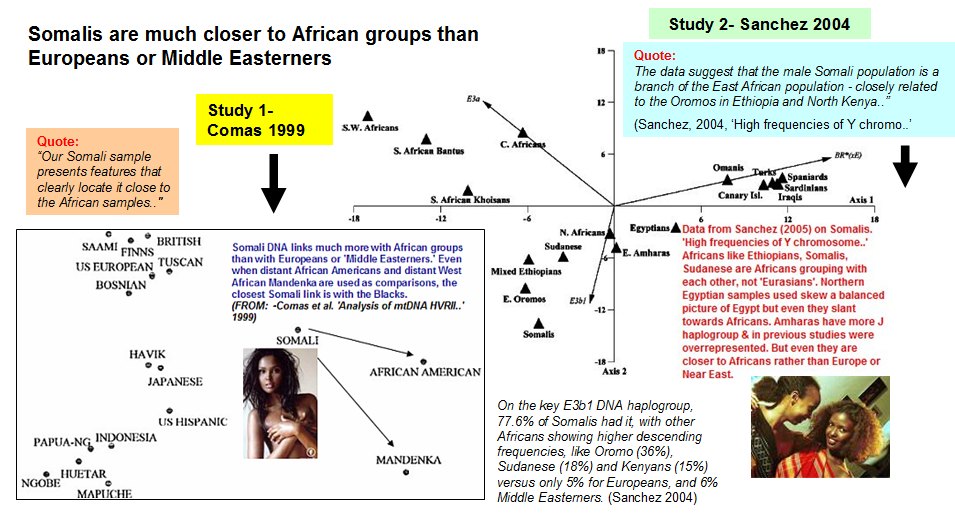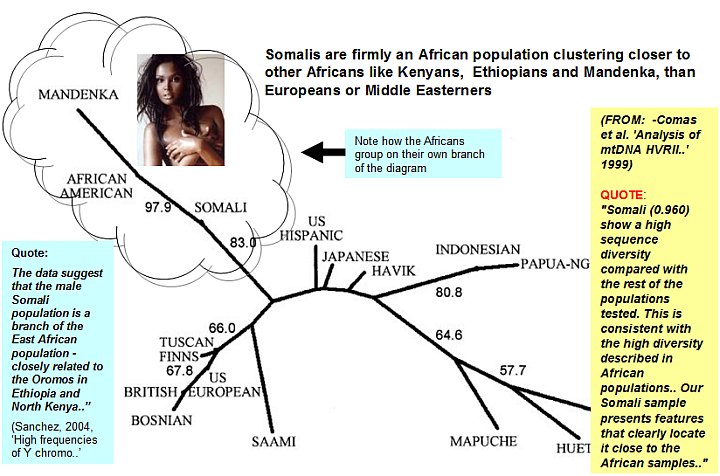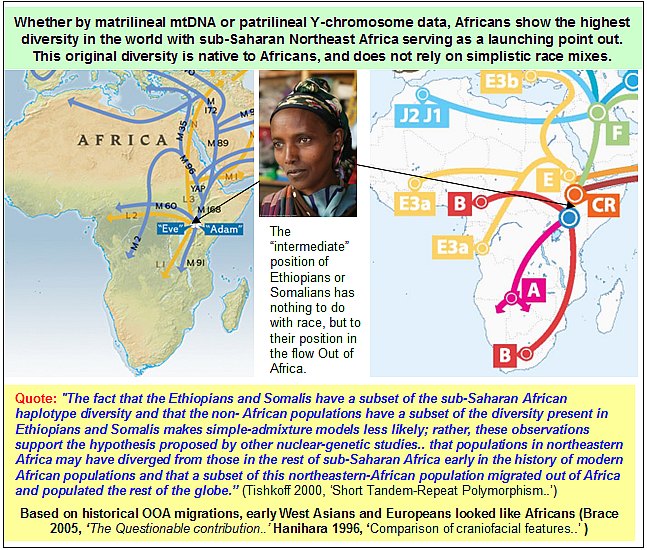|
Link to research papers and articles: (wysinger.homestead.com/keita.html) |
|
Link to current African DNA research: (http://exploring-africa.blogspot.com/) |
|
Google Search- other data
Home page |
Home | Quotations | Misc Notes | Notes 2 | Hair | DemicDiff | Diversity | DNA| Asian IQ | Keita2008 data | Blood | Debunk3
Egypt
in Africa |
Black-Greek-DNA links | Notes
3 |Notes
4| Notes
5 | Notes
6 |
Notes 7 | Misc
news clips | Ethiopians
| Nubians
|
African Tmeline| Mesopotamia
| Egypt-
A Tropical Civ | Notes8|
Notes
9 | Notes
10 | Notes
11
|
Link to research papers and articles: (wysinger.homestead.com/keita.html) |
|
Link to current African DNA research: (http://exploring-africa.blogspot.com/) |
|
Google Search- other data
Home page |
East African and Ethiopian population studies- notes
Afrocentric critic Brace debunks 'white Ethiopian' model
'An earlier generation of anthropologists tried to explain face form in the Horn of Africa as the result of admixture from hypothetical “wandering Caucasoids,” (Adams, 1967, 1979; MacGaffey, 1966; Seligman, 1913, 1915, 1934), but that explanation founders on the paradox of why that supposedly potent “Caucasoid” people contributed a dominant quantity of genes for nose and face form but none for skin color or limb proportions. It makes far better sense to regard the adaptively significant features seen in the Horn of Africa as solely an in situ response on the part of separate adaptive traits to the selective forces present in the hot dry tropics of eastern Africa. From the observation that 12,000 years was not a long enough period of time to produce any noticeable variation in pigment by latitude in the New World and that 50,000 years has been barely long enough to produce the beginnings of a gradation in Australia (Brace, 1993a), one would have to argue that the inhabitants of the Upper Nile and the East Horn of Africa have been equatorial for many tens of thousands of years.
'
-C.L. Brace (1993) Clines and Clusters

"The Ethiopians comprise different ethnic groups..and are classified as African, genetically speaking.."
"Given their relationship for more than three thousand years, it is not surprising that the Africans and Ethiopians sit together on the genetic tree.."
--Luigi Luca Cavalli-Sforza, Francesco Cavalli-Sforza, Sarah Thorne. (1995). The great human diasporas By Basic Books,
1995
"Considering both paternal and maternal lineages, only 5.4% of the mtDNAs can be classified as Caucasoid (table 3), whereas 25.4% of the Ethiopian Y chromosomes have a clear Caucasoid origin."
"Therefore, our mtDNA data do not support the hypothesis that a significant portion of the Ethiopian gene pool has a maternal Caucasoid origin."
-- Passarino, G., et al. (1998). Different Genetic Components in the Ethiopian Population
Ethiopians and Somalis group with other Africans
rather than Europeans or "Middle easterners"




Modern DNA shows that Horn of Africa populations like Ethiopians are locally derived due to long evolutionary time in Africa, genetic drift, climate and other factors etc. and are not due to any race mixes with Eurasians, contradicting claims of Cavalli-Sforza et. al.
"Comparative genetic studies on geographically diverse populations provide evidence of high levels of diversity in continental Africa. Sarah Tishkoff and her colleagues (1986) find an intermediate pattern of genetic variation at the CD4 locus in northeastern (actually Horn) African populations. They explain this by local evolution and not by admixture with Eurasians. In essence they are describing a gradient of differentiation. The Horn, largely at the latitude of Nigeria, contains a subset of the diversity seen in other African regions. Tishkoff and her colleagues suggest that the Horn's inhabitant's are the local descendants of those who left Africa to populate the world."
".. the Horn of Africa certainly contributed more recently to the Near East, because based on linguistic re- construction and the principles of "least moves" and "greatest
diversity." It is the geographical home of the ancestor of Afro-Asiatic languages, spoken primarily in Africa with one member in the Near East (Semitic) (Ehret 1984, 1995; Ruhlen 1987). Early Afro-Asiatic spread out from the Horn and did not come into Africa from Asia (brought by "Caucasians") as was believed at one time, and as is occasionally assumed by non-linguists (e.g., Barbujani and Pilastro 1993; Cavalli-Sforza and Cavalli-Sforza 1995). In fact, there is evidence for movement out of Africa at the very time some claim in-migration (Bar-Josef 1987). By the time of the radiation of Afro-Asiatic speakers there was already genetic differentiation in Africa due to African biohistorical processes.
There is no need to postulate massive European settler colonization of Africa or genetic swamping and/or settler colonization by Eurasians, as is implied or stated in some contemporary genetic work (Cavalli-Sforza et al. 1994), echoing the now defunct Hamitic hypothesis. Continental African variation may be interpreted largely without external mass invasions. The antiquity of modern humans in Africa means that there has been time to accumulate a large amount of random genetic variation (Cavalli-Sforza et. al. 1983), which has been shaped by great ecological diversity in the continent (Hiernaux 1975). Genetic drift
would also contribute to variability due to fluctuations in population size as founder effects and population expansion events occurred throughout the continent. Therefore it is far more accurate to speak of a range of
biohistorical African variants than different races of Africans. Northern Africans are more accurately conceptualized as primarily the products of differentiation than of hybridization."
( S.O.Y. Keita and R. Kittles. The Persistence
of Racial Thinking and the Myth of Racial Divergence, S. O. Y. Keita, Rick A.
Kittles, American Anthropologist, New Series, Vol. 99, No. 3 (Sep., 1997), pp.
534-544)
Simplistic "race percentage" models are dubious in Africa which has the highest genetic diversity in the world. That diversity proceeded from deeper sub-Saharan Africa, to East and N.E. Africa, then to the rest of the globe. All other populations, including Europeans and "Middle easterners" carry this diversity which was built into Africa to begin with. Africans thus don't need any "race mix" to look different. Their diversity is built-in and supplied the whole globe. Any returnees or "backflow" to Africa looked like Africans, including Europeans. (Brace 2005, Hanihara 1996, Holliday 2003).
" These studies suggest a recent and primary
subdivision between African and non-African populations, high levels of
divergence among African populations, and a recent shared common ancestry of
non-African populations, from a population originating in Africa. The
intermediate position, between African and non-African populations, that the
Ethiopian Jews and Somalis occupy in the PCA plot also has been observed in
other genetic studies (Ritte et al. 1993; Passarino et al. 1998) and could be
due either to shared common ancestry or to recent gene flow. The fact that the
Ethiopians and Somalis have a subset of the sub-Saharan African haplotype
diversity and that the non-African populations have a subset of the diversity
present in Ethiopians and Somalis makes simple-admixture models less likely;
rather, these observations support the hypothesis proposed by other
nuclear-genetic studies (Tishkoff et al. 1996a, 1998a, 1998b; Kidd et al. 1998)
that populations in northeastern Africa may have diverged from those in the rest
of sub-Saharan Africa early in the history of modern African populations and
that a subset of this northeastern-African population migrated out of Africa and
populated the rest of the globe. These conclusions are supported by recent mtDNA
analysis (Quintana-Murci et al. 1999)."
[Tishkoff et al. (2000) Short Tandem-Repeat Polymorphism/Alu Haplotype
Variation at the PLAT Locus: Implications for Modern Human Origins. Am J Hum
Genet; 67:901-925]
Data on Ethiopian peoples like the Oromo are underreported even though
they make up the largest group percentage wise in the Ethiopian
population, (50%) and are often pooled with others, hiding and obscuring
their overall contribution to the Ethiopian gene pool.
"This difference, not revealed in the study by Passarino et al. (1998), in
which the Oromo were underrepresented, might reflect distinct population
histories."
(--Semino, et
al. (2002). Ethiopians and Khoisan Share the Deepest Clades of the Human
Y..")
"These data, together with those reported elsewhere (Ritte et al. 1993a, 1993b; Hammer et al. 2000) suggest that the Ethiopian Jews acquired their religion without substantial genetic admixture from Middle Eastern peoples and that they can be considered an ethnic group with essentially a continental African genetic composition." (Cruciani, et. al Am J Hum Genet. 2002 May; 70(5): 1197–1214. "A Back Migration from Asia to Sub-Saharan Africa Is Supported by High-Resolution Analysis of Human Y-Chromosome Haplotypes)
Ethiopians more related to Norwegians?

Wilson et al. 2001 (‘Population Genetic Structure..’) grouped 62% of Ethiopians with Norwegians, German/Eastern European Ashkenazi and Armenians. But his sampling downplayed the Oromo in the samples drawn from Addis Ababa. The Oromo make up the majority of the Ethiopian population and have more sub-Saharan genes. They were lumped with the Amhara, relatively recent entrants who make up a smaller percent of the Ethiopian population and who have more Near eastern gene flow.
The Amhara
are approx. 50% of the population of Addis Abba (O’Conner 1983), skewing
the “Ethiopian” samples in a “Caucasoid” direction. This lumping
served to mask & downplay the sub-Saharan elements, helping produce
Norwegian matches, etc.
Simplistic "racial" models outmoded and unsuited for the complexity of African populations

"Genetic studies that attempt to recover the
biological history of the species have generally found that there is a split
between their restricted African samples and "the rest of the world."
These approaches conceptualize human population history as a series of
bifurcations with each node being relatively uniform. The "Africans"
usually used are either the short statured Aka or Mbuti, Khoisan speakers, or
West African stereotype s, in keeping with a socially, not scientifically
constructed concept of African. Studies using individuals as the unit of
analysis evince a different pattern. A select subset of Africans called the
"group of 49" forms a unit versus the rest of humankind. However the
latter individuals ("rest of humankind") also includes non-East
African sub-Saharans. Hence there is no "racial" split. As has been
stated, the idea that human variation can be described as being structured by
subspecies(races) that are treated as lineages is fundamentally false. In
actuality, also, although averages are used, the gene studies usually give us
histories that are not necessarily the same as population histories."
Writing African History Chapter 4, Physical Anthropology and African History,
Shomarka Keita University of Rochester Press p.134
Ethiopians share some of the deepest DNA links with one of the most ancient of African populations - the Khosians or San (aka 'Bushmen'). Khosians have several genetic strands but are predominantly and clearly an African population, not Eurasian.
"only the Ethiopians share with the Khoisan the deepest human Y-chromosome clades (the African specific Groups I and II) but with a repertoire of very different haplotypes. “
(-- Cavalli-Sforza et at. “Ethiopians and Khoisan Share the Deepest Clades of the Human y-chromosome Phylogeny” 2002)
Knight (2003- ‘African Y-chromosome and mtDNA..’ found that the Khoisan are similar to other sub-Saharan African populations, rather than Eurasians.
"According to Knight et al. (2003) Y-haplogroup A, the most diverse or oldest-diverging Y haplogroup transmitted purely by patrilineal descent, is today present in various Khoisan groups at frequencies of 12-44%, and the other Y-haplogroups present have been formed by recent admixture of Bantu male lineages E3a (18-54%), and in some groups, noticeable Pygmy traces are visible (B2b). The Khoisan also show the largest genetic diversity in matrilineally transmitted mtDNA of all human populations. Their original mtDNA haplogroups L1d and L1k are one of the oldest-diverging female lineages as well. However, analysis of neutral autosomal (inherited through either parent) genes finds that the Khoisan are similar to other sub-Saharan African
populations.'
(See--*Knight, Alec, et al.: African Y chromosome and mtDNA divergence provides insight into the history of click languages. Current Biology, 13, 464-473 (2003).)
"In a comparison of the different groups of Ethiopians, the Oromo show an incidence (62.8%) of the M35 cluster higher than that in the Amhara (35.4%, P<.005); the Amhara value is similar to the frequency (31.8%) found in the Ethiopian sample of Underhill et al. (2000).
Among them, the Amhara are by far the most important component (33.4%, vs. 3.8% for the Oromo [P<.0001] and 3.4% for the other Ethiopian data [P < .0001]). This difference, not revealed in the study by Passarino et al. (1998), in which the Oromo were underrepresented, might reflect distinct population histories. It is reported (Levine 1974) that the Amhara experienced a strong influence from Middle Eastern populations, in which the 12f2 8-kb allele has a very high frequency and probably originated
(Santachiara-Benerecetti et al. 1993; Semino et al. 1996; Quintana-Murci et al. 2001). This is further supported by the opposite distribution of the M35 subclade (35.4% for the
Amhara, vs. 62.8% for the Oromo [P<.005] and 31.8% for the other Ethiopian data)."
(- Semino, Cavalli-Sforza et al.. Ethiopians and Khosians share...)
.
The BLUE color indicates either (a) Original African DNA variants that spread out to other parts of Africa and then on into Europe and the Middle East, or (b) downstream subsets of the original African DNA returning to Africa from Europe or the Middle East. Both Neolithic Europeans (Brace 2005) and Middle Easterners/West Asians looked like Africans (Hanihara 1996), not modern Europeans. Whatever the origin, among the Ethiopians, the BLUE appears mostly in the outlier Beta Israel population, not the main line Ethiopian samples, and even in the Beta Israel sample, BLUE is minor.
-- From: Tishkoff et al (2009) The Genetic Structure and History of Africans and African Americans. SCIENCE vol 324
Cranial data confirm the same as to
Somalis- they cluster overwhelming with other Africans like Kenyans

BLOOD TYPE DATA ALSO SHOW SOMALIS CLUSTERING OVERWHELMING WITH OTHER AFRICANS


mtdna 2008 - Ethiopians cluster more with Nubians in this particular study rather than Europeans or Middle Easterners


Home | Quotations |
| Misc Notes | Notes 2 | Hair | DemicDiff | DiversityEgypt in Africa | Black-Greek-DNA links | Notes 3 | Notes 4| Misc news clips | Ethiopians